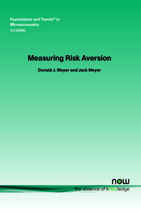Measuring Risk Aversion
By Donald J. Meyer, Western Michigan University, Department of Economics, USA, donald.meyer@wmich.edu | Jack Meyer, Michigan State University, Department of Economics, USA, jmeyer@msu.edu
Abstract
The purpose of the survey is to summarize, discuss, and interpret published research concerning the risk aversion of decision makers who maximize expected utility. In doing this, two points are emphasized. First, any measure of risk aversion is specific to the particular outcome variable over which the measure is defined or estimated, and second when outcome variables are related, then their risk aversion measures are also related. These two points are used to show that a substantial portion of the reported variation in magnitudes and slopes of risk aversion measures from the research of the past forty years results from differences in the outcome variables, and when these differences are adjusted for, those findings are a quite consistent body of evidence.
Measuring Risk Aversion
The measurement of the propensity to accept or reject risk is an important and well researched topic. Measuring Risk Aversion summarizes, discusses, and interprets the published research on this topic for decision makers who maximize expected utility. Estimates of the magnitude of relative risk aversion range widely from near zero to values approaching one hundred, and whether the slope of the risk aversion measure is positive, negative or zero is an unsettled question for many measures, including relative risk aversion. Measuring Risk Aversion show that a substantial part of this variation is due to the differences in the outcome variables used in the analysis. Measuring Risk Aversion provides a detailed discussion of the adjustment of risk references and how to go about making such adjustments to a common scale. By adjusting all information to this common scale, results across studies can be easily summarized and compared, and the body of information concerning risk aversion can be examined as a whole rather than as individual parts.
